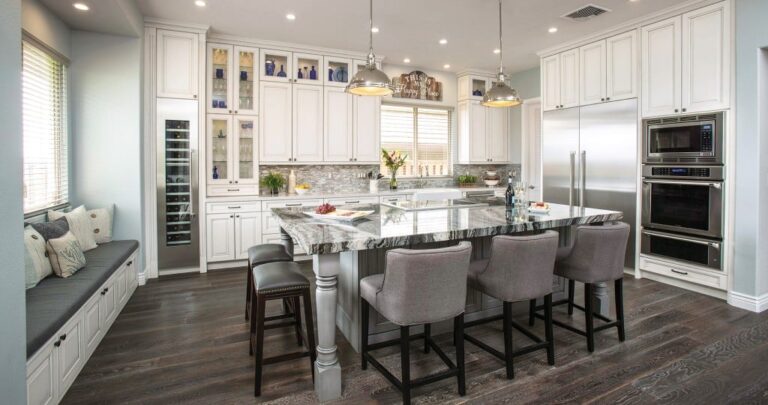Whole-Home Renovations: A Comprehensive Guide
The decision to undertake a whole-home renovation is a crucial milestone in homeownership, signifying an exciting transformational journey. A whole-home renovation is a spectacular project, whether you want to modernize an older house, adapt your living space to your changing needs, or simply freshen the look and usefulness of your home. However, it is not to be taken lightly. It necessitates meticulous planning, a clear vision, and a dedication to seeing the project through to completion. We will lead you through the whole process of whole-home renovations, from the initial planning stages to the finishing touches, in this thorough guide. We’ll go over important concerns, design inspiration, financial advice, and the value of expert services in attaining your restoration goals.
Chapter 1: The Vision
Setting Specific Goals
It’s critical to clarify your vision and objectives before embarking on a whole-house makeover. What are your project objectives? Are you looking to improve the aesthetics, functionality, or energy efficiency of your home, or all of the above? Setting specific goals will help you make better judgments throughout the renovation process.
Choosing between Needs and Wants
Separate your necessary needs from your wishlist products. Understanding your priorities can help you allocate your funds more effectively and make more informed design and material selections.
Chapter 2: Design and Planning
Making a Renovation Strategy
A well-planned remodeling project is the foundation of a successful undertaking. Work with a professional architect or designer to create specific plans outlining the improvements you want to make to the layout, construction, and aesthetics of your home.
Inspiration for Design
Find design ideas in journals, online platforms, and even home improvement shows. Make mood boards and design concepts to help you picture your ideal house.
Wise Budgeting
Determine your renovation budget and set aside money for unanticipated costs. Be realistic about your financial capabilities and, if necessary, seek the advice of a financial expert.
Chapter 3: Professional Services
Professional Builders and Contractors
It is strongly advised to use expert builders or contractors for whole-home renovations. Their expertise, experience, and industry understanding are vital in efficiently implementing your vision. Permits and inspections, as well as managing subcontractors and ensuring the project stays on schedule and under budget, can all be handled by professionals.
Choosing the Best Professionals
Thoroughly research and interview possible builders or contractors. Examine their credentials, evaluations, and previous projects to confirm they are consistent with your vision and beliefs. To safeguard both parties’ interests, request precise bids and contracts.
Chapter 4: Demolition and Planning
Demolition
Typically, the renovation process begins with demolition. To prepare the area for the new design, existing structures, fittings, and finishes must be removed. Demolition must be done correctly for safety and to create a clean slate for the construction phase.
Modifications to the Structure
If your renovation includes structural changes, such as the removal of walls or the addition of extensions, this is the stage in which such changes are made. To ensure the integrity of your property, structural modifications should always be performed by skilled professionals such as Axelle Builder Company.
Chapter 5: Construction Laying the Groundwork
Building the Foundation
The foundation is the first step in any construction project, whether it’s fixing an old one or building a new one for your newly refurbished space. This phase establishes the tone for the entire project and necessitates accuracy and attention to detail.
Rough-Ins and Framing
Making the skeleton of your space, determining room layouts, and incorporating structural features are all part of framing. During this phase, rough-ins for plumbing, electrical, and HVAC systems are also installed.
Drywall and Insulation
Insulation is critical for energy efficiency and environmental control. Following the installation of insulation, drywall is used to form the internal walls and ceilings of your refurbished spaces.
Finishes and Flooring
To fit your design choices, choose and install flooring materials such as hardwood, tile, or carpet. Trim, moldings, and paint all contribute to the overall appearance.
Chapter 6: Plumbing and Electrical Plumbing Upgrades
Plumbing Upgrades
Plumbing system modernization can enhance water efficiency and lower utility bills. Consider replacing fixtures, repairing any leaks, and making sure there is sufficient drainage.
Electrical Improvements
Update your electrical system to meet current safety requirements and to fit the needs of your home. This could include installing extra outlets, improving lighting fixtures, and incorporating smart home technologies.
Chapter 7: Interior Design
Interior Design Ideas
Collaborate with an interior designer to make your concept a reality. They can help you with color palettes, furniture selection, and establishing a coherent design that complements the style of your home.
Countertops and Cabinetry
In kitchens, baths, and other areas, install bespoke cabinetry and worktops. Material that is both useful and visually beautiful should be considered.
Lighting Designs
Effective lighting design improves the atmosphere and functionality of your house. Include ambient, task, and accent lighting to create a well-lit and inviting environment.
Chapter 8: Landscaping and the Exterior
Visual Attraction
Improve the curb appearance of your home with new siding, roofing, windows, and landscaping. A well-kept exterior makes a favorable first impression.
Design of Landscaping
Invest in landscaping that compliments the decor of your home and enhances outdoor living spaces. Garden beds, hardscaping, and irrigation systems are all important considerations.
Chapter 9: Finishing Touches
Final Examinations
Final inspections should be scheduled to confirm that all renovations comply with local building laws and regulations. Address any difficulties as soon as possible in order to receive the appropriate permissions.
Cleaning and Quality Assurance
Clean your newly remodeled room thoroughly and perform quality control tests. Check that all finishes and fixtures satisfy your standards.
Install and Have Fun
When your entire-home remodel is finished and fulfills your expectations, it’s time to move in and enjoy your newly renovated living spaces.
Conclusion
A whole-home makeover is a significant effort that demands meticulous planning, professional knowledge, and a clear vision of your objectives. It is a process with several stages, from early planning and design to building and finishing touches. Throughout the process, the advice of professional builders and contractors such as https://axellebuilders.com/ can make or break your renovation dreams. Remember that each step you take puts you closer to the home you’ve always wanted, where style, functionality, and comfort coexist in perfect harmony.






